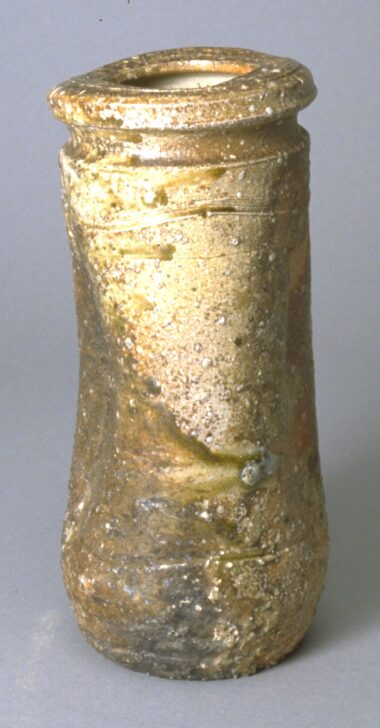Shigaraki Ware Flower Vase
Takahashi Rakusai III

Description
Takahashi Rakusai III
Japan, 1898–1976
Vase
Showa period (1926–1989)
1960–63
Stoneware with natural ash glaze
Museum purchase, 1963/2.77
Plate
Showa period (1926–1989)
circa 1960
Stoneware with natural ash glaze
Museum purchase, 1963/2.76
Takahashi Rakusai III, who came from a long line of Shigaraki potters, employed the same clay and wood-firing technique used in the jars and vases prized by tea masters of the Momoyama period (1583–1615) to create powerful and whimsical wares for the modern era. Although this vase has a classic form, Takahashi achieves a dynamic effect through the combination of rough surface and green ash glaze. The rectangular plate is more playful: the dots on the unglazed, scorched top are areas that were protected from the flame by cylindrical clay spacers.
(Turning Point, Spring 2010)
Momoyama pots could be both an inspiration and a burden for twentieth-century Japanese potters. One way they found to express personal creativity within tradition was to mix and match allusions to different regional models. (An imperfect analogy would be contemporary furniture in a "Southwestern" style done in mahogany, or a Chippendale reproduction piece in teak.) In this flower vase, Takahashi Rakusai exploits all of the potential of Shigaraki clay and the wood-firing process: compare the texture and color of the vase to the sixteenth-century Shigaraki jar on the platform at right. The overall shape and deliberate deformities, however, are copied from the wares of the neighboring kiln at Iga.
Takahashi welcomed many American potters to his Shigaraki studio over the years and his work is well represented in Michigan collections.
Exhibited in "Japanese Costumes & Ceramics, Past & Present," October 2001-February 2002. Maribeth Graybill, Senior Curator of Asian Art
---
Takahashi Rakusai III, who came from a long line of Shigaraki potters, employed the same clay and wood-firing technique used in the jars and vases prized by tea masters of the Momoyama period (1583–1615) to create powerful and whimsical wares for the modern era. Although this vase has a classic form, Takahashi achieves a dynamic effect through the combination of rough surface and green ash glaze. The rectangular plate is more playful: the dots on the unglazed, scorched top are areas that were protected from the flame by cylindrical clay spacers.
(Turning Point exhibition, Spring 2010)
Subject Matter:
This is a flower vase made at the kiln in Shigaraki.
Physical Description:
The vase uses Shigaraki clay and the wood-firing process. The deformities and imperfections are intentional, and in Iga style. It has a lopsided lip edge at the top, with a deep indentation circling the vase just below it. The texture of this piece is splotchy and ridged, and the colors are earth tones, ranging from tans to dark, forest greens.
Usage Rights:
If you are interested in using an image for a publication, please visit https://umma.umich.edu/request-image/ for more information and to fill out the online Image Rights and Reproductions Request Form.